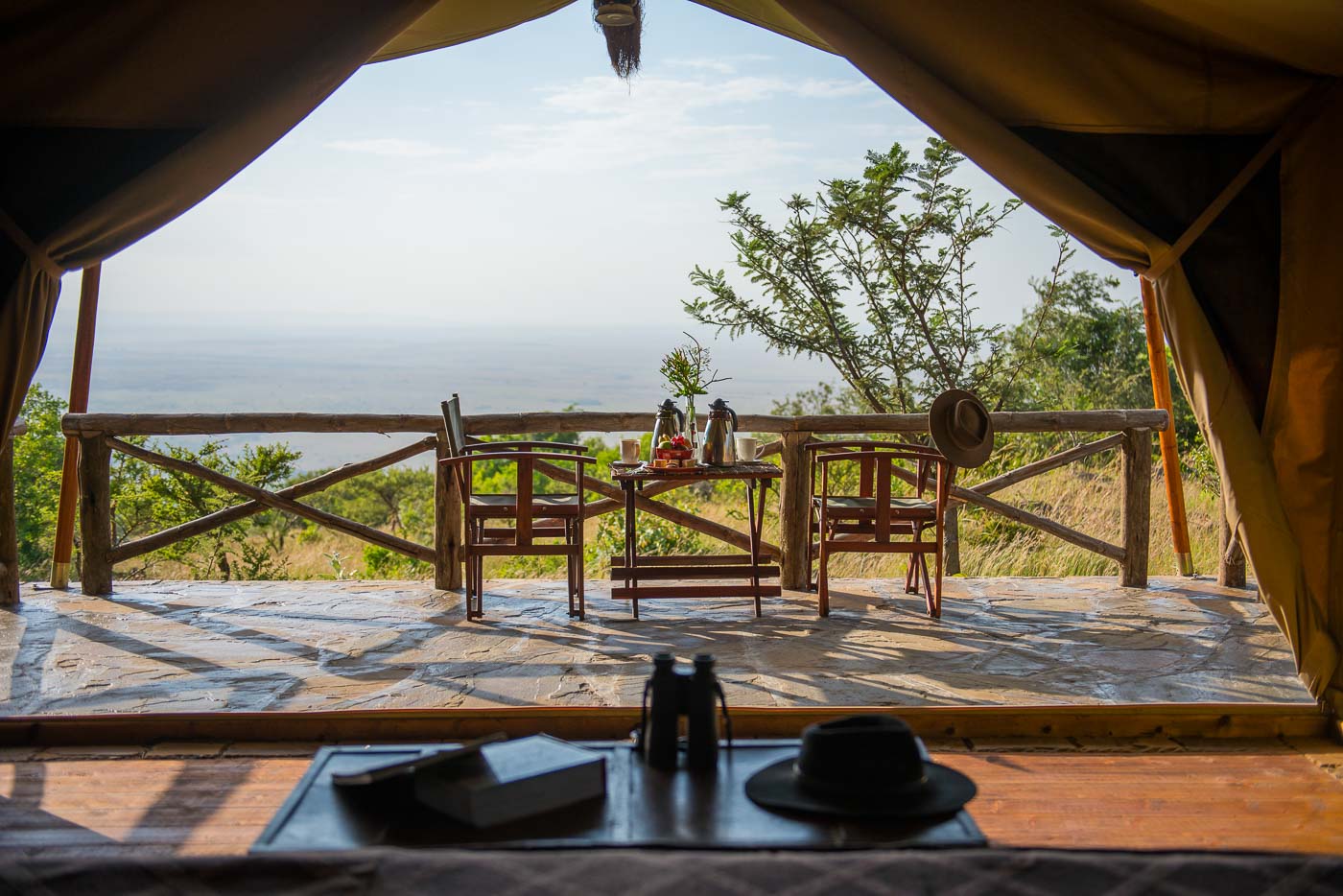When the chartered prop plane flew passed Kilimanjaro’s snowy peak, I knew that the adventure that comes standard with a safari in the Serengeti awaited. However, when my traveling companions and I landed on the grassy private airstrip at Cottar’s 1920s Camp just outside Kenya’s Masai Mara National Park, I realized that not only would it be an adventure, but a trip back in time.
That’s because this luxury camp is a throwback to a golden age of safaris, when glamorous and camping need not be merged into the portmanteau glamping. Back then, high standards came with the territory; camping was simply “living out in the bush in style.” Cottar’s 1920s Camp delivers what its moniker implies: a high-end safari camp as it was in the early 20th century, when the Western World got wind of explorers’ tales in sub-Saharan Africa. It was Teddy Roosevelt’s tales that inspired one Charles Cottar to go to East Africa from America, and eventually move his family there in 1915 to establish a safari service — one that has endured for almost a century through his descendants — complete with the first American vehicles to grace the Kenyan countryside.
A vintage Ford Model A (refitted with a modern Land Rover engine) picked us up, and the transport continued to be both spatial and seemingly temporal. We were welcomed at the main mess tent, which boasted an elegance of yesteryear with fine Oriental rugs, gramophones, old typewriters, and other antique tchotchkes. I felt like I should have packed a vintage pith helmet, but soon noticed some nearby for me to don. Meanwhile, the Kenyan staff sported red fezzes to complement their formal white uniforms, which seemed a little odd to me at first; in reality, we’re not actually in the old era of European imperialism — but I will admit, it did add to the charm.
Game drives at Cottar’s were scheduled like most safari outfitters: early in the morning and near dusk, the optimal times to see wildlife on the move — or on the prowl, depending on its position on the food chain. Shaded, open-air Land Rovers (modern ones) drove us through Cottar’s own 6,000-acre private reserve and parts of Masai Mara National Park, to shoot the zebras, elephants, and multitude of antelopes with our cameras. The highlight was our chance lion encounter, and despite the sight of blood, we were enthralled as a pride munched down on a buffalo carcass merely 25 feet in front of us.
Dining in the outdoors always provided a sense of awe. After one morning game drive, our guide drove us to a shaded area for a short hike, only to reveal a glamorous picnic set up in the bush — glam-nicking perhaps? — a moveable brunch staffed by a bartender and a chef manning a propane-powered omelet station. Sundowners at the end of an afternoon game drive weren’t as filling; in lieu of orange yolks in skillets was the giant one in the sky sinking down into the horizon, which exuded an unavoidable sense of awe while we sipped gin and tonics around a campfire.
Suppers at Cottar’s 1920s Camp were something of a time paradox. Dining on multi-course meals featuring steaks, risotto, and red snapper worthy of a Michelin-rated restaurant were reminders that we were still in a modern time of rapid importation and refrigeration, despite the shadows our silverware being cast by the little flames atop old candelabras, and the ambient 1920s jazz. Although our wine-influenced dinner conversations amongst my fellow travelers were free-spirited, I believed we were dignitaries in a Hemingway novel.
I felt quite dignified staying in one of the “standard” tents — which had fairly high standards of any era. The canvas enclosure was as spacious as a large hotel room, but felt larger in the daytime when the staff rolled up three of the walls to let the breeze pass over the antique wooden furniture and bed — a bed that was especially comfortable after I’d been startled and realized that the hot water bottle put under my comforter with the turndown service was not a hiding wild animal. The fourth wall was never broken for it led to the bathroom with plumbing for hot showers and an old-fashioned pull chain toilet.
My tent was one sanctuary for the leisurely afternoons in camp. It was where the camp’s masseuse ported the spa experience with a massage table, and where I’d sit in a rocking chair on the shaded “porch” and gaze out at the Mara while sipping on a complimentary glass of sherry from the tent’s decanter. Swimming was also an option at the camp’s infinity pool. Its design may have been a flash-forward to the modern world, but “bush baths” in canvas tubs were alternatively available for those who wanted to relax in suds in a wilder, more old-fashioned way.
The safari experience may have evolved over the decades in Kenya, but if you want to do it in vintage style, Cottar’s 1920s Camp successfully recreates the romance, elegance, and adventure of safari’s hey-day. As I donned a pith helmet from the mess tent and hopped in a vintage Ford, I realized that going on safari with Cottars 1920s Camp is more than glamping; it’s also glam-time travel.









